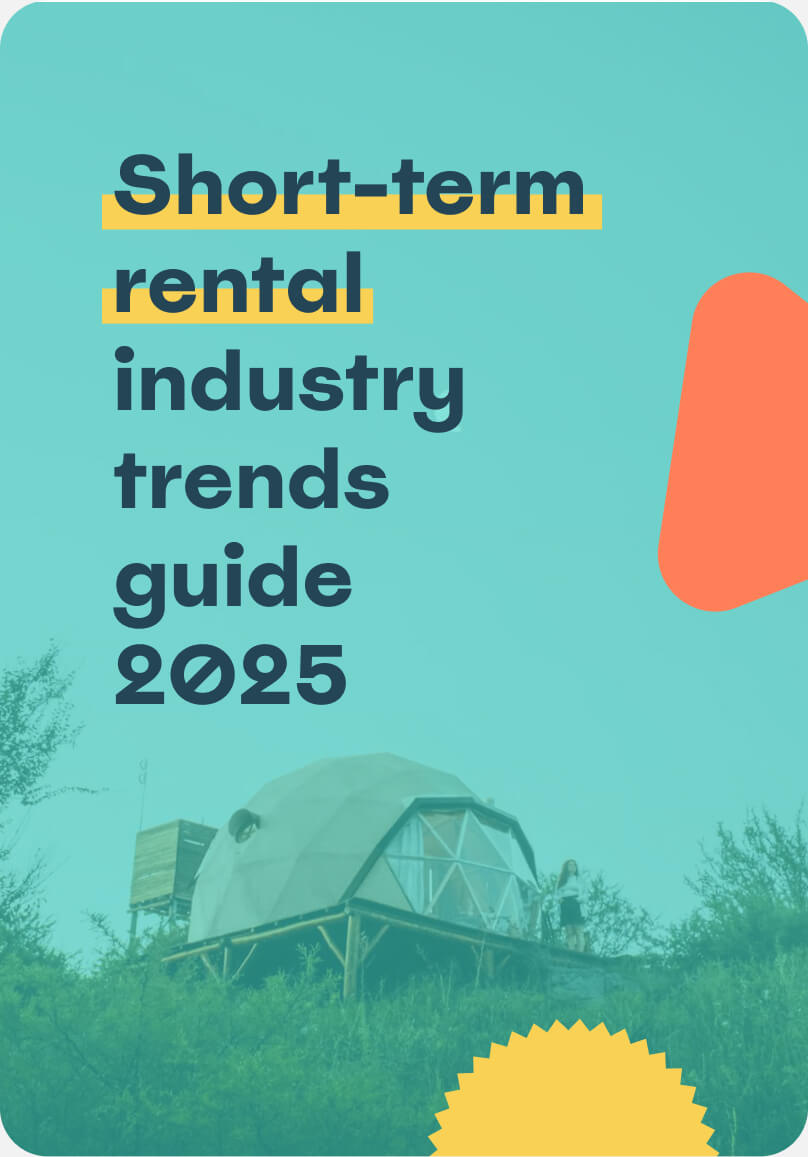Maintaining your Airbnb rental property is essential to ensure a positive guest experience, reduce costly repairs, and protect your investment. A proactive property maintenance plan not only keeps your rental in top shape but also helps you comply with local regulations. This guide will walk you through everything you need to know to efficiently manage maintenance tasks, from routine upkeep to budgeting, plus leveraging technology like digital guidebooks. We’re going to cover:
- Understanding the basics of rental property maintenance
- Creating a rental property maintenance plan
- Managing repairs and contractors
- Budgeting for maintenance costs
- Final thoughts
Want to streamline your rental property management?
Understanding the basics of rental property maintenance
Rental property maintenance is not just about fixing what’s broken; it’s about preventing issues before they arise. A well-maintained property ensures your guests have a seamless experience, leading to positive reviews and repeat bookings. In this section, we’ll cover the importance of regular upkeep, the legal responsibilities you need to be aware of, and how maintaining your property benefits your bottom line.
Why maintenance matters
Keeping up with maintenance ensures:
- Preserved property value: Regular maintenance such as repainting, repairing small cracks, and fixing plumbing issues will prevent further deterioration. Properties that are well-maintained command higher market value and retain their appeal to guests. Well-kept properties also tend to stand out on booking platforms like Airbnb, increasing occupancy rates and generating better revenue.
- Tenant safety and comfort: Functional electrical systems, properly sealed windows, and operational smoke detectors are crucial for guest safety. Ensuring comfortable living conditions with functional heating, cooling, and appliances also leads to positive reviews. Guests are more likely to recommend a well-maintained property, leading to repeat bookings and increased visibility on booking sites.
- Cost savings: Preventative maintenance such as cleaning HVAC filters, inspecting roofs for leaks, and checking for water damage can avoid expensive repairs later on. Small, proactive investments in upkeep lead to long-term financial savings. Additionally, routine maintenance allows you to detect and address issues before they become major expenses.
Pro tip: Just starting out on your journey as a landlord? Check out our guide to rental property cleaning best practices.
Legal responsibilities for landlords
Landlords are typically required to provide habitable living conditions. While specific laws vary by region, common obligations include:
- Ensuring working plumbing, heating, and electrical systems: Regular checks and prompt repairs ensure compliance with health and safety standards. For example, in colder climates, landlords must ensure heating systems are operational during the winter months.
- Maintaining structural integrity: Repairing cracks, roof damage, and external walls prevents further issues and ensures guest safety. A property with a leaky roof or a damaged foundation can result in costly litigation and loss of business.
- Providing smoke and carbon monoxide detectors: Install detectors in key areas like kitchens and bedrooms. Ensure they are regularly tested and batteries are replaced. Many regions require carbon monoxide detectors by law, particularly in properties with gas appliances.
- Complying with health and safety regulations: Follow local building codes, especially for electrical wiring, gas systems, and fire exits. Maintaining a record of inspections and maintenance work can demonstrate compliance if disputes arise.
Pro tip: Use our Inspection checklist for rental properties (including free template!) to make your property inspections work for both you and your tenants.
Creating a rental property maintenance plan
A comprehensive maintenance plan is the key to keeping your property in top shape while minimising unexpected expenses. By planning routine maintenance tasks and preparing for seasonal challenges, you can address minor problems before they escalate. This section provides a step-by-step guide to creating and managing an effective maintenance plan.
Routine maintenance tasks
Regular inspections and minor repairs can prevent larger issues. Add these to your checklist:
- HVAC system checks: Clean or replace air filters every 1-3 months. Schedule professional servicing twice a year to maintain efficient operation and extend lifespan. Neglecting HVAC maintenance can lead to poor air quality and reduced energy efficiency.
- Plumbing inspections: Check for leaks under sinks, around toilets, and behind appliances. Inspect water heaters for rust or sediment buildup and flush annually. Early detection of leaks can prevent water damage and mould growth.
- Electrical system reviews: Test outlets and switches for proper function. Schedule licensed electricians for inspections every few years to check for outdated wiring. Faulty wiring is a major safety hazard and could lead to electrical fires.
- Pest control prevention: Perform quarterly pest control treatments and seal any cracks or gaps where pests could enter. Even small infestations can lead to guest complaints and poor reviews.
Seasonal maintenance checklist
A seasonal maintenance routine ensures your property remains in excellent condition year-round.
- Spring: Clean gutters to prevent water damage, inspect the roof for leaks, and trim overgrown branches. Conduct landscaping to refresh the exterior appearance and boost curb appeal.
- Summer: Service air conditioning units to ensure they work efficiently. Inspect patios, decks, and outdoor furniture for wear. Prevent pests by sealing entry points and applying treatments.
- Fall: Check heating systems and fireplaces before temperatures drop. Seal gaps in windows and doors to improve insulation. Clear fallen leaves from gutters and drainage areas.
- Winter: Prevent frozen pipes by insulating exposed plumbing. Regularly check for ice buildup on walkways and roofs. Maintain adequate heating to prevent damage caused by freezing temperatures.
Pro tip: Learn how to make your property accessible for guests with disabilities.
Emergency repairs
Emergencies are inevitable. Common examples include:
- Burst pipes: Shut off the water supply immediately and contact a plumber. Consider using a water leak detection system for early warnings.
- Gas leaks: Evacuate the property, avoid using electrical appliances, and contact emergency services and your gas provider.
- Electrical failures: Reset circuit breakers if possible. If the issue persists, contact a licensed electrician.
- Heating or cooling malfunctions: Provide temporary heating or cooling units for guests and call for professional repairs.
Having an emergency repair protocol with a list of trusted contractors ensures issues are addressed promptly.
As a rental landlord, your time is precious. Reclaim it with a digital guidebook.
Managing repairs and contractors
When to DIY vs. when to hire professionals
Some tasks are simple enough to handle yourself, while others require licensed contractors.
- DIY: Tasks like unclogging drains, patching small wall holes, replacing door handles, or applying fresh paint can be done by landlords or property managers.
- Hire professionals: Licensed electricians should handle any electrical rewiring. Structural repairs, major plumbing issues, and appliance installation should be performed by certified contractors.
Building a reliable contractor network
To build a dependable contractor network:
- Research and read online reviews: Use platforms like Google Reviews or Yelp to find well-rated professionals.
- Request quotes and compare rates: Collect at least three quotes before selecting a contractor to ensure fair pricing.
- Establish long-term relationships: Contractors who are familiar with your property can often provide quicker and more efficient service.
- Have backups for emergencies: Maintain a list of alternative contractors for different specialties to avoid delays during emergencies.
Budgeting for maintenance costs
Estimating annual maintenance expenses
A general rule is to set aside 1-2% of your property’s value annually for maintenance. Factors to consider:
- Age and condition of the property: Older properties often require more frequent repairs and upkeep.
- Frequency of tenant turnover: Higher turnover means increased wear and tear. Budget for repainting, carpet cleaning, and minor repairs between tenancies.
- Local climate and weather patterns: Properties in areas prone to heavy rainfall, snow, or heat may require additional maintenance for roofs, pipes, or HVAC systems.
Pro tip: Discover how to nail your rental cleaning schedule with our ultimate cleaning checklist.
Creating a maintenance reserve fund
Having a reserve fund can prevent financial stress during emergencies. A good guideline is to save £50-100 per month per property. For larger properties or those with frequent turnover, consider increasing this amount.
Final thoughts
In conclusion, a successful rental property maintenance plan hinges on a proactive approach, encompassing:
- regular inspections
- timely repairs
- seasonal upkeep
By adopting a proactive stance and investing in preventative measures, you'll not only safeguard your investment but also cultivate a reputation for excellence, ensuring your rental property thrives in the competitive market. A well-maintained rental property leads to satisfied guests, positive reviews, and consistent bookings. By implementing a solid maintenance plan, budgeting effectively, and leveraging technology, you can minimise downtime and maximise your investment.
Ready to simplify your rental property management? Try Touch Stay free for 14 days and discover how our digital guidebooks can enhance your guest experience while saving you time.

Ned
Ned has clocked up over 11 years in digital marketing and comms, with a strong focus on creating engaging content for a range of brands and agencies. When he’s not writing, he can be found digging for records, peering through his telescope at the night sky, or onboard his local lifeboat where he volunteers as a crewmember.
Be the first to know!
Join our newsletter for early access to:
- ✅ Free guides
- ✅ Pro tips & tricks
- ✅ Time saving tutorials
- ✅ Latest blog posts
- ✅ Checklists & templates




















